Sports Psychology: Effective Coaching and Leadership Report Analysis
VerifiedAdded on 2022/08/31
|13
|4397
|68
Report
AI Summary
This report provides a comprehensive analysis of effective coaching behaviors within the framework of sports psychology, addressing a specific assignment brief focused on a new netball coach, Sanjeev, who lacks confidence. The report begins by applying Chelladurai's Multidimensional Model of Leadership to help Sanjeev develop his coaching skills, discussing the model's components of required, preferred, and actual behaviors, along with the congruence hypothesis. It then explores the role of transformational leadership in coaching, emphasizing how Sanjeev can inspire his team members, adapt to change, and foster a positive environment. The report further examines how to create an effective coaching environment, highlighting the importance of celebrating success, providing constructive feedback, and ensuring proper facilities and resources. Finally, it discusses the impact of coaching behaviors on team performance, including a job analysis of coaching and differentiating between coaching products and procedures. The report offers practical strategies and supporting research to help Sanjeev improve his coaching abilities and achieve optimal team performance.

Sports psychology
Paraphrase This Document
Need a fresh take? Get an instant paraphrase of this document with our AI Paraphraser
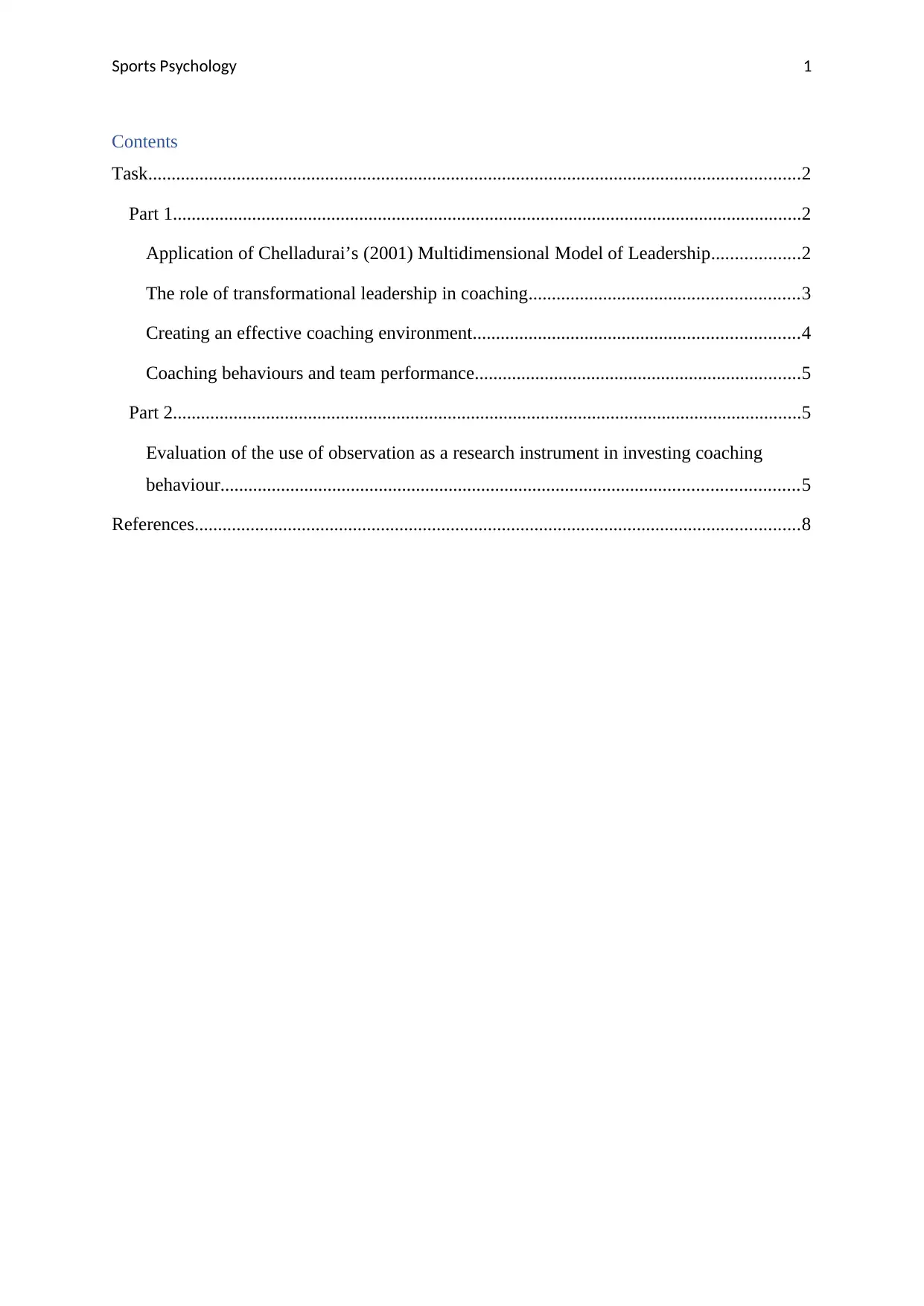
Sports Psychology 1
Contents
Task............................................................................................................................................2
Part 1.......................................................................................................................................2
Application of Chelladurai’s (2001) Multidimensional Model of Leadership...................2
The role of transformational leadership in coaching..........................................................3
Creating an effective coaching environment......................................................................4
Coaching behaviours and team performance......................................................................5
Part 2.......................................................................................................................................5
Evaluation of the use of observation as a research instrument in investing coaching
behaviour............................................................................................................................5
References..................................................................................................................................8
Contents
Task............................................................................................................................................2
Part 1.......................................................................................................................................2
Application of Chelladurai’s (2001) Multidimensional Model of Leadership...................2
The role of transformational leadership in coaching..........................................................3
Creating an effective coaching environment......................................................................4
Coaching behaviours and team performance......................................................................5
Part 2.......................................................................................................................................5
Evaluation of the use of observation as a research instrument in investing coaching
behaviour............................................................................................................................5
References..................................................................................................................................8
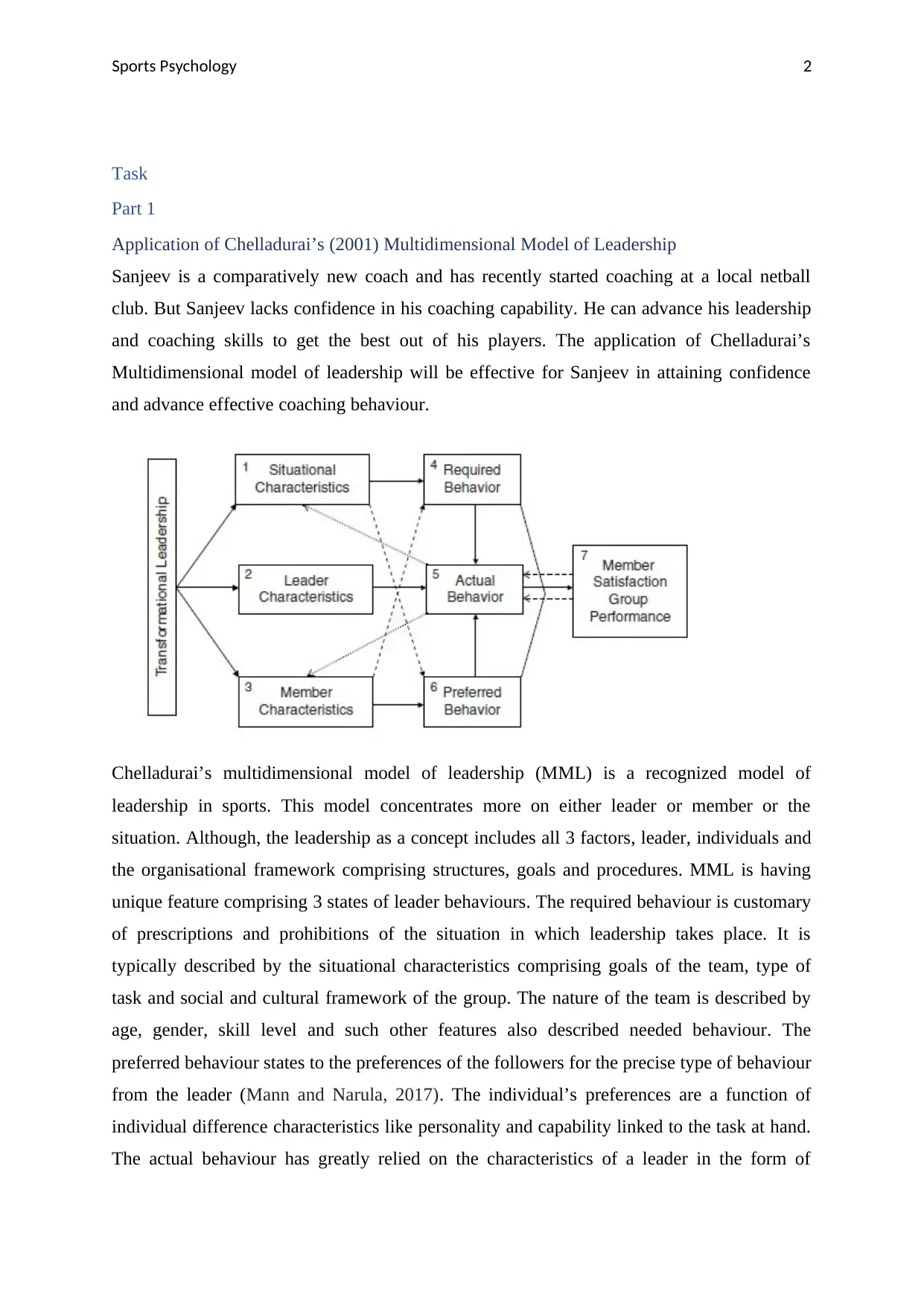
Sports Psychology 2
Task
Part 1
Application of Chelladurai’s (2001) Multidimensional Model of Leadership
Sanjeev is a comparatively new coach and has recently started coaching at a local netball
club. But Sanjeev lacks confidence in his coaching capability. He can advance his leadership
and coaching skills to get the best out of his players. The application of Chelladurai’s
Multidimensional model of leadership will be effective for Sanjeev in attaining confidence
and advance effective coaching behaviour.
Chelladurai’s multidimensional model of leadership (MML) is a recognized model of
leadership in sports. This model concentrates more on either leader or member or the
situation. Although, the leadership as a concept includes all 3 factors, leader, individuals and
the organisational framework comprising structures, goals and procedures. MML is having
unique feature comprising 3 states of leader behaviours. The required behaviour is customary
of prescriptions and prohibitions of the situation in which leadership takes place. It is
typically described by the situational characteristics comprising goals of the team, type of
task and social and cultural framework of the group. The nature of the team is described by
age, gender, skill level and such other features also described needed behaviour. The
preferred behaviour states to the preferences of the followers for the precise type of behaviour
from the leader (Mann and Narula, 2017). The individual’s preferences are a function of
individual difference characteristics like personality and capability linked to the task at hand.
The actual behaviour has greatly relied on the characteristics of a leader in the form of
Task
Part 1
Application of Chelladurai’s (2001) Multidimensional Model of Leadership
Sanjeev is a comparatively new coach and has recently started coaching at a local netball
club. But Sanjeev lacks confidence in his coaching capability. He can advance his leadership
and coaching skills to get the best out of his players. The application of Chelladurai’s
Multidimensional model of leadership will be effective for Sanjeev in attaining confidence
and advance effective coaching behaviour.
Chelladurai’s multidimensional model of leadership (MML) is a recognized model of
leadership in sports. This model concentrates more on either leader or member or the
situation. Although, the leadership as a concept includes all 3 factors, leader, individuals and
the organisational framework comprising structures, goals and procedures. MML is having
unique feature comprising 3 states of leader behaviours. The required behaviour is customary
of prescriptions and prohibitions of the situation in which leadership takes place. It is
typically described by the situational characteristics comprising goals of the team, type of
task and social and cultural framework of the group. The nature of the team is described by
age, gender, skill level and such other features also described needed behaviour. The
preferred behaviour states to the preferences of the followers for the precise type of behaviour
from the leader (Mann and Narula, 2017). The individual’s preferences are a function of
individual difference characteristics like personality and capability linked to the task at hand.
The actual behaviour has greatly relied on the characteristics of a leader in the form of
⊘ This is a preview!⊘
Do you want full access?
Subscribe today to unlock all pages.

Trusted by 1+ million students worldwide
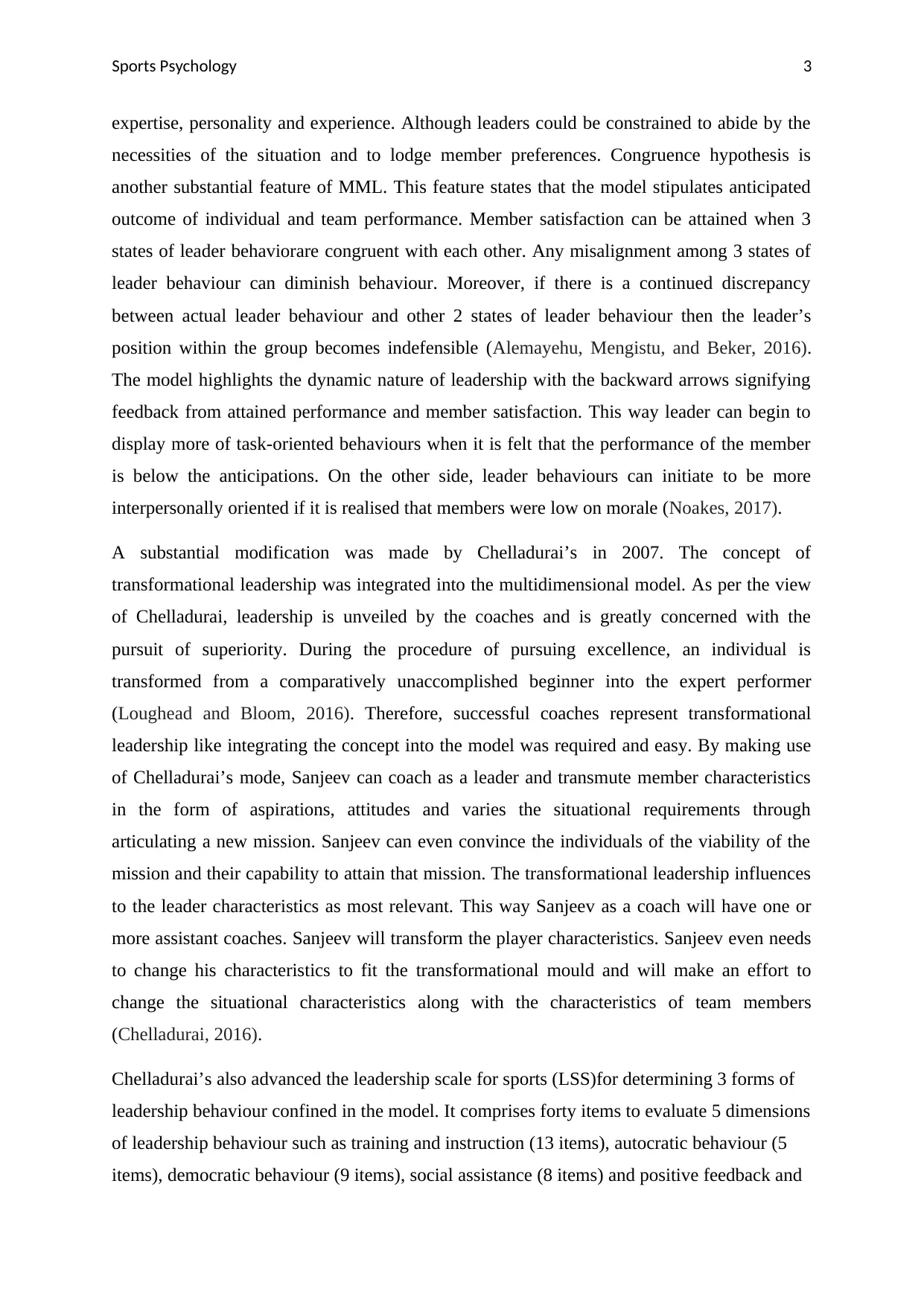
Sports Psychology 3
expertise, personality and experience. Although leaders could be constrained to abide by the
necessities of the situation and to lodge member preferences. Congruence hypothesis is
another substantial feature of MML. This feature states that the model stipulates anticipated
outcome of individual and team performance. Member satisfaction can be attained when 3
states of leader behaviorare congruent with each other. Any misalignment among 3 states of
leader behaviour can diminish behaviour. Moreover, if there is a continued discrepancy
between actual leader behaviour and other 2 states of leader behaviour then the leader’s
position within the group becomes indefensible (Alemayehu, Mengistu, and Beker, 2016).
The model highlights the dynamic nature of leadership with the backward arrows signifying
feedback from attained performance and member satisfaction. This way leader can begin to
display more of task-oriented behaviours when it is felt that the performance of the member
is below the anticipations. On the other side, leader behaviours can initiate to be more
interpersonally oriented if it is realised that members were low on morale (Noakes, 2017).
A substantial modification was made by Chelladurai’s in 2007. The concept of
transformational leadership was integrated into the multidimensional model. As per the view
of Chelladurai, leadership is unveiled by the coaches and is greatly concerned with the
pursuit of superiority. During the procedure of pursuing excellence, an individual is
transformed from a comparatively unaccomplished beginner into the expert performer
(Loughead and Bloom, 2016). Therefore, successful coaches represent transformational
leadership like integrating the concept into the model was required and easy. By making use
of Chelladurai’s mode, Sanjeev can coach as a leader and transmute member characteristics
in the form of aspirations, attitudes and varies the situational requirements through
articulating a new mission. Sanjeev can even convince the individuals of the viability of the
mission and their capability to attain that mission. The transformational leadership influences
to the leader characteristics as most relevant. This way Sanjeev as a coach will have one or
more assistant coaches. Sanjeev will transform the player characteristics. Sanjeev even needs
to change his characteristics to fit the transformational mould and will make an effort to
change the situational characteristics along with the characteristics of team members
(Chelladurai, 2016).
Chelladurai’s also advanced the leadership scale for sports (LSS)for determining 3 forms of
leadership behaviour confined in the model. It comprises forty items to evaluate 5 dimensions
of leadership behaviour such as training and instruction (13 items), autocratic behaviour (5
items), democratic behaviour (9 items), social assistance (8 items) and positive feedback and
expertise, personality and experience. Although leaders could be constrained to abide by the
necessities of the situation and to lodge member preferences. Congruence hypothesis is
another substantial feature of MML. This feature states that the model stipulates anticipated
outcome of individual and team performance. Member satisfaction can be attained when 3
states of leader behaviorare congruent with each other. Any misalignment among 3 states of
leader behaviour can diminish behaviour. Moreover, if there is a continued discrepancy
between actual leader behaviour and other 2 states of leader behaviour then the leader’s
position within the group becomes indefensible (Alemayehu, Mengistu, and Beker, 2016).
The model highlights the dynamic nature of leadership with the backward arrows signifying
feedback from attained performance and member satisfaction. This way leader can begin to
display more of task-oriented behaviours when it is felt that the performance of the member
is below the anticipations. On the other side, leader behaviours can initiate to be more
interpersonally oriented if it is realised that members were low on morale (Noakes, 2017).
A substantial modification was made by Chelladurai’s in 2007. The concept of
transformational leadership was integrated into the multidimensional model. As per the view
of Chelladurai, leadership is unveiled by the coaches and is greatly concerned with the
pursuit of superiority. During the procedure of pursuing excellence, an individual is
transformed from a comparatively unaccomplished beginner into the expert performer
(Loughead and Bloom, 2016). Therefore, successful coaches represent transformational
leadership like integrating the concept into the model was required and easy. By making use
of Chelladurai’s mode, Sanjeev can coach as a leader and transmute member characteristics
in the form of aspirations, attitudes and varies the situational requirements through
articulating a new mission. Sanjeev can even convince the individuals of the viability of the
mission and their capability to attain that mission. The transformational leadership influences
to the leader characteristics as most relevant. This way Sanjeev as a coach will have one or
more assistant coaches. Sanjeev will transform the player characteristics. Sanjeev even needs
to change his characteristics to fit the transformational mould and will make an effort to
change the situational characteristics along with the characteristics of team members
(Chelladurai, 2016).
Chelladurai’s also advanced the leadership scale for sports (LSS)for determining 3 forms of
leadership behaviour confined in the model. It comprises forty items to evaluate 5 dimensions
of leadership behaviour such as training and instruction (13 items), autocratic behaviour (5
items), democratic behaviour (9 items), social assistance (8 items) and positive feedback and
Paraphrase This Document
Need a fresh take? Get an instant paraphrase of this document with our AI Paraphraser

Sports Psychology 4
rewarding behaviour (5 items). The response format under LLS is a five-point scale ranging
from 1 always, 2 often, almost 75% of the time, 3 occasionally almost 50% of the time, 4
rarely, almost 25% of the time and to 5 never. The scale is utilised to assess an athlete’s
preferences, their discernments of coach’s behaviour and coaches’ perceptions of their
behaviour about those 5 dimensions of behaviour. Sanjeev can make use of Chelladurai’s
model to report own behaviour as a surrogate of necessitated behaviour (McDowell, Huang,
and Caza, 2018). The future research can be deliberated to ask coach majorly about the
required behaviour in the given situation described by gender, age, capability levels, goals of
the organisation and more. It has been observed that the average of such responses can be
utilised as necessitated behaviour in the pertinent situation. Chelladurai’s model even
comprises the questionnaire from the team members to derive dimensions of the leader
behaviour by exploratory factor analysis. On the other side, the model also comprises group
performance and member satisfaction as the result variables (Billsberry, et al. 2018). Finally,
Chelladurai’s model not only has been successful in identifying coaches but also preferred
leadership qualities along with creating better leaders. But there are some occurrences where
preferred behaviour and required behaviour can struggle and cause problems.
The role of transformational leadership in coaching
The transformational leadership can be practised by Sanjeev in coaching. He will inspire his
team members to go further than they are capable of. Sanjeev will be assisting his team
members to above the expectations. In the modern scenario of sports, it becomes quite tough
to find ways to assist team members. The coach is required to be full of strength, confidence
and happiness. The coach performing well to encourage the team, then the level of
commitment remains high within the team. As a part of transformational leadership, Sanjeev
will be able to give team members accountability than anticipated to accomplish the role. If it
is expected own team members to get fail than other players should also be expected to get
fail (Chiu, Rodriguez and Won, 2016).
There should be clarity at the time of offering tasks to the team members. It should be
ensured that the team members are known of the desired results and should be enabled with
the liberty to perform the task. The team members should feel a sense of liberation and
authorization as they are trusted by the team members to attain the goals (Ntomali, et al.
2017). The leader should calm, feel safe and should not let its team members know how he
feels. Sanjeev as a coach should portray a positive attitude irrespective of the external
situation can be. The coach should be in control of his actions, words and emotions.
rewarding behaviour (5 items). The response format under LLS is a five-point scale ranging
from 1 always, 2 often, almost 75% of the time, 3 occasionally almost 50% of the time, 4
rarely, almost 25% of the time and to 5 never. The scale is utilised to assess an athlete’s
preferences, their discernments of coach’s behaviour and coaches’ perceptions of their
behaviour about those 5 dimensions of behaviour. Sanjeev can make use of Chelladurai’s
model to report own behaviour as a surrogate of necessitated behaviour (McDowell, Huang,
and Caza, 2018). The future research can be deliberated to ask coach majorly about the
required behaviour in the given situation described by gender, age, capability levels, goals of
the organisation and more. It has been observed that the average of such responses can be
utilised as necessitated behaviour in the pertinent situation. Chelladurai’s model even
comprises the questionnaire from the team members to derive dimensions of the leader
behaviour by exploratory factor analysis. On the other side, the model also comprises group
performance and member satisfaction as the result variables (Billsberry, et al. 2018). Finally,
Chelladurai’s model not only has been successful in identifying coaches but also preferred
leadership qualities along with creating better leaders. But there are some occurrences where
preferred behaviour and required behaviour can struggle and cause problems.
The role of transformational leadership in coaching
The transformational leadership can be practised by Sanjeev in coaching. He will inspire his
team members to go further than they are capable of. Sanjeev will be assisting his team
members to above the expectations. In the modern scenario of sports, it becomes quite tough
to find ways to assist team members. The coach is required to be full of strength, confidence
and happiness. The coach performing well to encourage the team, then the level of
commitment remains high within the team. As a part of transformational leadership, Sanjeev
will be able to give team members accountability than anticipated to accomplish the role. If it
is expected own team members to get fail than other players should also be expected to get
fail (Chiu, Rodriguez and Won, 2016).
There should be clarity at the time of offering tasks to the team members. It should be
ensured that the team members are known of the desired results and should be enabled with
the liberty to perform the task. The team members should feel a sense of liberation and
authorization as they are trusted by the team members to attain the goals (Ntomali, et al.
2017). The leader should calm, feel safe and should not let its team members know how he
feels. Sanjeev as a coach should portray a positive attitude irrespective of the external
situation can be. The coach should be in control of his actions, words and emotions.

Sports Psychology 5
Transformational leadership is the most desired leadership style in the sports industry. In this
leadership style, the emotions, motives and requirements of the team members are embraced
before the leader’s own. The sports require changes which necessitates adaptation and
survival. Therefore, it is significant to know the way to adapt to changes. The changes are
inevitable in the sports industry (Li, et al. 2019). The sports members in the industry are
feeling scared to the idea of change as it is a disruption in the normal routine and lack of
inevitability in the leadership. Although adapting to change can enhance the scope of sports
along with building a relationship with the coach. Sanjeev can also opt another way as a
transformational leader in sports and can create an environment which is acceptance of
change by generating depth in the organisation. It results in forming various dimensions of
depth that should be developed by Sanjeev as a leader within the team (O’Boyle, Shilbury
and Ferkins, 2019). The first dimension identified is relationship depth. It tackles with
forming meaningful links among the leaders and team members along with advancing a level
of appreciation for the persons who are part of the team. Another dimension identified is
diversity depth comprising experiences, backgrounds, different skills and guidance within the
team. The team through personal experience work better together and compliment each other.
The transformational leadership for Sanjeev will also be turned out as optimistic
organisational outcomes such as commitment, job satisfaction and apparent leader
effectiveness. It also led to a higher level of identification and involvement. There will also
be the usage of intrinsic motivation and team members advancement (Lee, Hwang and Choi,
2017).
Creating an effective coaching environment
An effective coach assists rider to attain their potential. It means to identify team member’s
needs, aspirations and motivations. In an effective coaching environment, success should be
celebrated and the achievements of the team members should be recognised. It states to focus
on how sports members develop and identify when they enhance their performance. Sanjeev
as a coach should inspire team members to concentrate on their performance than the
performance of others. This way, team members can excel in spite they finish first or last. It
is the job of the coach to identify when processes are performed well (Pitts, Nyambane and
Butler, 2018). It necessitates a capability to observe and offer specific and constructive
feedback. The effective coaching environment comprises world-class facilities and resources
required. Sanjeev will be liable for creating and an efficient environment favourable to the
Transformational leadership is the most desired leadership style in the sports industry. In this
leadership style, the emotions, motives and requirements of the team members are embraced
before the leader’s own. The sports require changes which necessitates adaptation and
survival. Therefore, it is significant to know the way to adapt to changes. The changes are
inevitable in the sports industry (Li, et al. 2019). The sports members in the industry are
feeling scared to the idea of change as it is a disruption in the normal routine and lack of
inevitability in the leadership. Although adapting to change can enhance the scope of sports
along with building a relationship with the coach. Sanjeev can also opt another way as a
transformational leader in sports and can create an environment which is acceptance of
change by generating depth in the organisation. It results in forming various dimensions of
depth that should be developed by Sanjeev as a leader within the team (O’Boyle, Shilbury
and Ferkins, 2019). The first dimension identified is relationship depth. It tackles with
forming meaningful links among the leaders and team members along with advancing a level
of appreciation for the persons who are part of the team. Another dimension identified is
diversity depth comprising experiences, backgrounds, different skills and guidance within the
team. The team through personal experience work better together and compliment each other.
The transformational leadership for Sanjeev will also be turned out as optimistic
organisational outcomes such as commitment, job satisfaction and apparent leader
effectiveness. It also led to a higher level of identification and involvement. There will also
be the usage of intrinsic motivation and team members advancement (Lee, Hwang and Choi,
2017).
Creating an effective coaching environment
An effective coach assists rider to attain their potential. It means to identify team member’s
needs, aspirations and motivations. In an effective coaching environment, success should be
celebrated and the achievements of the team members should be recognised. It states to focus
on how sports members develop and identify when they enhance their performance. Sanjeev
as a coach should inspire team members to concentrate on their performance than the
performance of others. This way, team members can excel in spite they finish first or last. It
is the job of the coach to identify when processes are performed well (Pitts, Nyambane and
Butler, 2018). It necessitates a capability to observe and offer specific and constructive
feedback. The effective coaching environment comprises world-class facilities and resources
required. Sanjeev will be liable for creating and an efficient environment favourable to the
⊘ This is a preview!⊘
Do you want full access?
Subscribe today to unlock all pages.

Trusted by 1+ million students worldwide
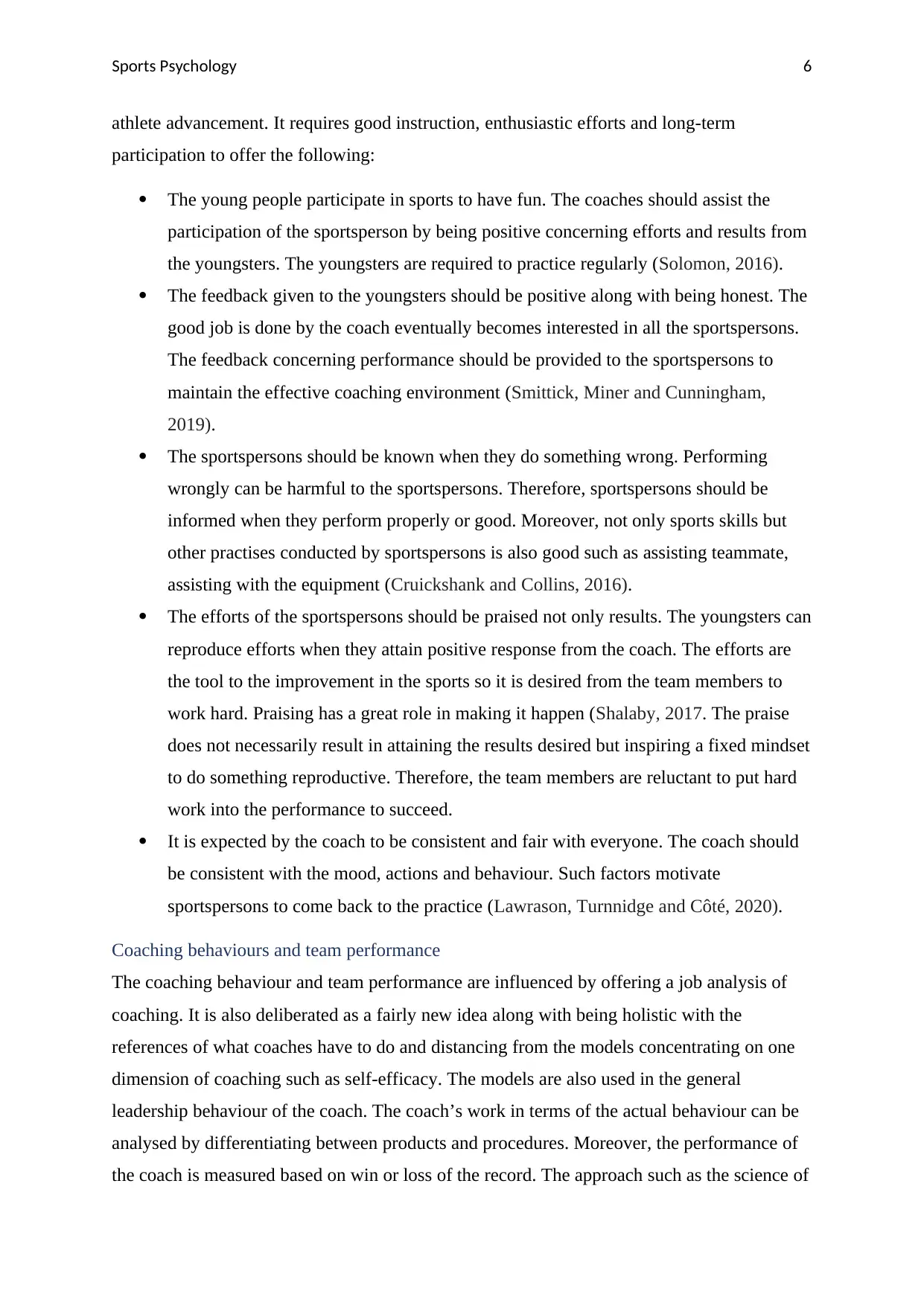
Sports Psychology 6
athlete advancement. It requires good instruction, enthusiastic efforts and long-term
participation to offer the following:
The young people participate in sports to have fun. The coaches should assist the
participation of the sportsperson by being positive concerning efforts and results from
the youngsters. The youngsters are required to practice regularly (Solomon, 2016).
The feedback given to the youngsters should be positive along with being honest. The
good job is done by the coach eventually becomes interested in all the sportspersons.
The feedback concerning performance should be provided to the sportspersons to
maintain the effective coaching environment (Smittick, Miner and Cunningham,
2019).
The sportspersons should be known when they do something wrong. Performing
wrongly can be harmful to the sportspersons. Therefore, sportspersons should be
informed when they perform properly or good. Moreover, not only sports skills but
other practises conducted by sportspersons is also good such as assisting teammate,
assisting with the equipment (Cruickshank and Collins, 2016).
The efforts of the sportspersons should be praised not only results. The youngsters can
reproduce efforts when they attain positive response from the coach. The efforts are
the tool to the improvement in the sports so it is desired from the team members to
work hard. Praising has a great role in making it happen (Shalaby, 2017. The praise
does not necessarily result in attaining the results desired but inspiring a fixed mindset
to do something reproductive. Therefore, the team members are reluctant to put hard
work into the performance to succeed.
It is expected by the coach to be consistent and fair with everyone. The coach should
be consistent with the mood, actions and behaviour. Such factors motivate
sportspersons to come back to the practice (Lawrason, Turnnidge and Côté, 2020).
Coaching behaviours and team performance
The coaching behaviour and team performance are influenced by offering a job analysis of
coaching. It is also deliberated as a fairly new idea along with being holistic with the
references of what coaches have to do and distancing from the models concentrating on one
dimension of coaching such as self-efficacy. The models are also used in the general
leadership behaviour of the coach. The coach’s work in terms of the actual behaviour can be
analysed by differentiating between products and procedures. Moreover, the performance of
the coach is measured based on win or loss of the record. The approach such as the science of
athlete advancement. It requires good instruction, enthusiastic efforts and long-term
participation to offer the following:
The young people participate in sports to have fun. The coaches should assist the
participation of the sportsperson by being positive concerning efforts and results from
the youngsters. The youngsters are required to practice regularly (Solomon, 2016).
The feedback given to the youngsters should be positive along with being honest. The
good job is done by the coach eventually becomes interested in all the sportspersons.
The feedback concerning performance should be provided to the sportspersons to
maintain the effective coaching environment (Smittick, Miner and Cunningham,
2019).
The sportspersons should be known when they do something wrong. Performing
wrongly can be harmful to the sportspersons. Therefore, sportspersons should be
informed when they perform properly or good. Moreover, not only sports skills but
other practises conducted by sportspersons is also good such as assisting teammate,
assisting with the equipment (Cruickshank and Collins, 2016).
The efforts of the sportspersons should be praised not only results. The youngsters can
reproduce efforts when they attain positive response from the coach. The efforts are
the tool to the improvement in the sports so it is desired from the team members to
work hard. Praising has a great role in making it happen (Shalaby, 2017. The praise
does not necessarily result in attaining the results desired but inspiring a fixed mindset
to do something reproductive. Therefore, the team members are reluctant to put hard
work into the performance to succeed.
It is expected by the coach to be consistent and fair with everyone. The coach should
be consistent with the mood, actions and behaviour. Such factors motivate
sportspersons to come back to the practice (Lawrason, Turnnidge and Côté, 2020).
Coaching behaviours and team performance
The coaching behaviour and team performance are influenced by offering a job analysis of
coaching. It is also deliberated as a fairly new idea along with being holistic with the
references of what coaches have to do and distancing from the models concentrating on one
dimension of coaching such as self-efficacy. The models are also used in the general
leadership behaviour of the coach. The coach’s work in terms of the actual behaviour can be
analysed by differentiating between products and procedures. Moreover, the performance of
the coach is measured based on win or loss of the record. The approach such as the science of
Paraphrase This Document
Need a fresh take? Get an instant paraphrase of this document with our AI Paraphraser

Sports Psychology 7
training is critically viewed. Add on, a fact such as drawing practical implications influences
coach education on the various levels (Dominski, et al. 2018).
The effective coach is one who prompts successful performance outcomes or positive
psychological responses on the part of the sportspersons. The coaches do not only have a role
in the physical performance of the team members but also their psychological well-being. An
effective coach needs to become attuned with the personal and private needs of the
sportspersons. The effective coaches should also undertake technical skills of the sports team.
Leadership Scale for the Sports (LSS) has also a great role in measuring apparent coaching
behaviours and questionnaires. The team members also believe that the coaches employing
an advanced democratic leadership style and offers a great level of social assistance, positive
feedback and training remarks to the greater level of team cohesion. Coaching behaviour also
employs a differentiated research approach (Cruz and Kim, 2017). It recognises the strategies
and techniques used by the coaches to encourage or challenge team cohesion. The
perceptions of coach behaviour are also assessed with the open-ended questionnaires. Other
than this, the qualitative approach has also a great role in obtaining thorough data from the
team members on perceiving the coach’s behaviour on them (Shang and Ku, 2018).
Part 2
Evaluation of the use of observation as a research instrument in investing coaching behaviour
The use of the observation in identifying the coach’s behaviour has been consistent to attain
substantial research interest. It offers significant insights which are added to the body of
sports coaching knowledge. There are some methods which have been popularly employed in
coaching behaviour. The systematic observation method comprises a three-phase approach.
Phase first comprised, searching the EBSCO HOST database. The precise databases searched
comprise educational research complete, academic search complete, ERIC, psyarticles,
psycbooks, sport discuss and psycinfo (Kim and Cruz, 2016). These are systematic
observation and coaching and behaviour. The closely terms used in the studies are known to
have utilised a systematic method like coach and sportsperson and learning to make sure that
all the relevant article met the inclusion criteria recognized.
The phase two widened the search elsewhere the databases to comprise other studies meeting
the inclusion criteria. Moreover, the peer-reviewed study has been undertaken, the
participants in the study were coaches and systematic observation instrument to observe
coaching behaviour concerned towards players. The widened study has been attained by
training is critically viewed. Add on, a fact such as drawing practical implications influences
coach education on the various levels (Dominski, et al. 2018).
The effective coach is one who prompts successful performance outcomes or positive
psychological responses on the part of the sportspersons. The coaches do not only have a role
in the physical performance of the team members but also their psychological well-being. An
effective coach needs to become attuned with the personal and private needs of the
sportspersons. The effective coaches should also undertake technical skills of the sports team.
Leadership Scale for the Sports (LSS) has also a great role in measuring apparent coaching
behaviours and questionnaires. The team members also believe that the coaches employing
an advanced democratic leadership style and offers a great level of social assistance, positive
feedback and training remarks to the greater level of team cohesion. Coaching behaviour also
employs a differentiated research approach (Cruz and Kim, 2017). It recognises the strategies
and techniques used by the coaches to encourage or challenge team cohesion. The
perceptions of coach behaviour are also assessed with the open-ended questionnaires. Other
than this, the qualitative approach has also a great role in obtaining thorough data from the
team members on perceiving the coach’s behaviour on them (Shang and Ku, 2018).
Part 2
Evaluation of the use of observation as a research instrument in investing coaching behaviour
The use of the observation in identifying the coach’s behaviour has been consistent to attain
substantial research interest. It offers significant insights which are added to the body of
sports coaching knowledge. There are some methods which have been popularly employed in
coaching behaviour. The systematic observation method comprises a three-phase approach.
Phase first comprised, searching the EBSCO HOST database. The precise databases searched
comprise educational research complete, academic search complete, ERIC, psyarticles,
psycbooks, sport discuss and psycinfo (Kim and Cruz, 2016). These are systematic
observation and coaching and behaviour. The closely terms used in the studies are known to
have utilised a systematic method like coach and sportsperson and learning to make sure that
all the relevant article met the inclusion criteria recognized.
The phase two widened the search elsewhere the databases to comprise other studies meeting
the inclusion criteria. Moreover, the peer-reviewed study has been undertaken, the
participants in the study were coaches and systematic observation instrument to observe
coaching behaviour concerned towards players. The widened study has been attained by
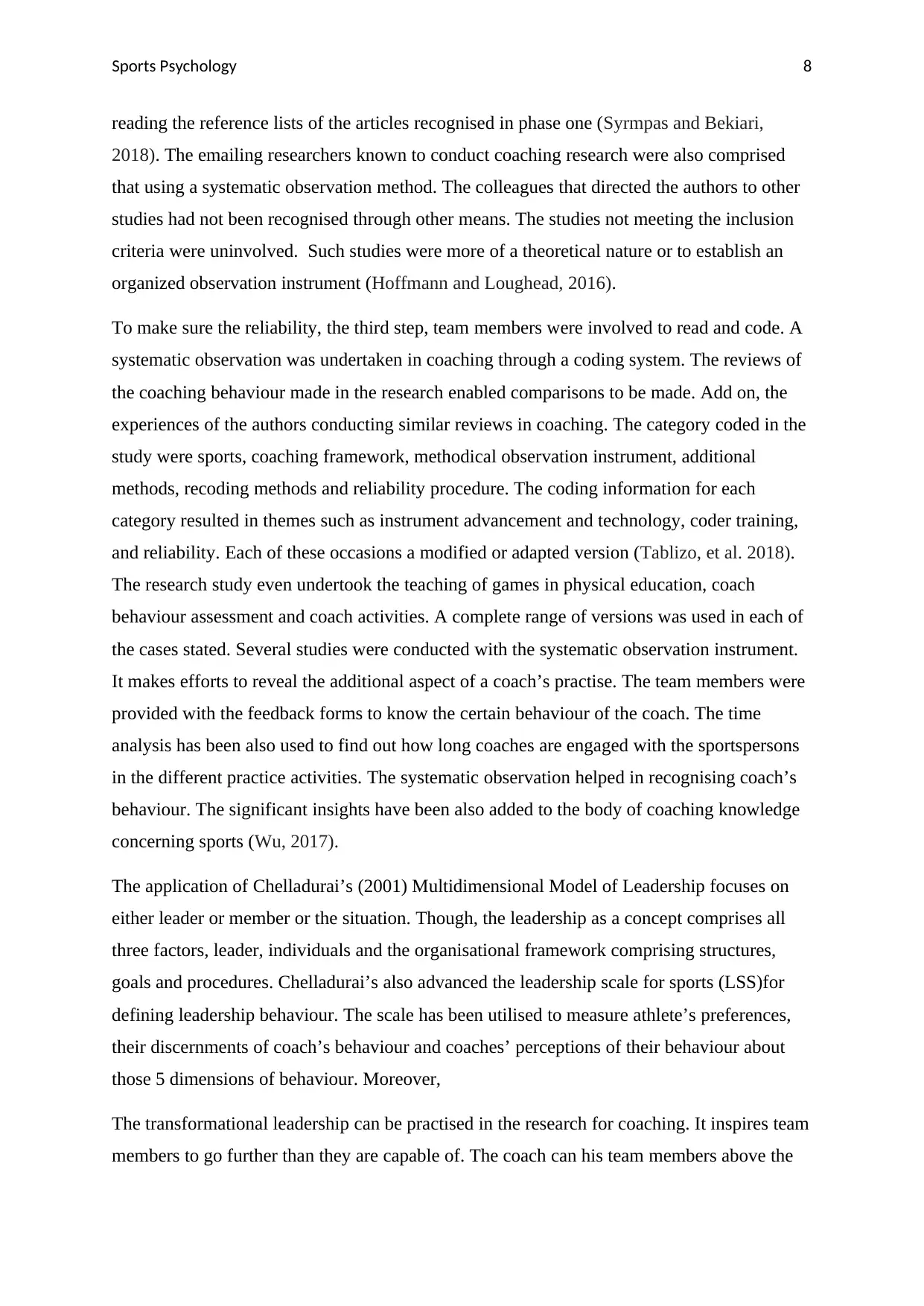
Sports Psychology 8
reading the reference lists of the articles recognised in phase one (Syrmpas and Bekiari,
2018). The emailing researchers known to conduct coaching research were also comprised
that using a systematic observation method. The colleagues that directed the authors to other
studies had not been recognised through other means. The studies not meeting the inclusion
criteria were uninvolved. Such studies were more of a theoretical nature or to establish an
organized observation instrument (Hoffmann and Loughead, 2016).
To make sure the reliability, the third step, team members were involved to read and code. A
systematic observation was undertaken in coaching through a coding system. The reviews of
the coaching behaviour made in the research enabled comparisons to be made. Add on, the
experiences of the authors conducting similar reviews in coaching. The category coded in the
study were sports, coaching framework, methodical observation instrument, additional
methods, recoding methods and reliability procedure. The coding information for each
category resulted in themes such as instrument advancement and technology, coder training,
and reliability. Each of these occasions a modified or adapted version (Tablizo, et al. 2018).
The research study even undertook the teaching of games in physical education, coach
behaviour assessment and coach activities. A complete range of versions was used in each of
the cases stated. Several studies were conducted with the systematic observation instrument.
It makes efforts to reveal the additional aspect of a coach’s practise. The team members were
provided with the feedback forms to know the certain behaviour of the coach. The time
analysis has been also used to find out how long coaches are engaged with the sportspersons
in the different practice activities. The systematic observation helped in recognising coach’s
behaviour. The significant insights have been also added to the body of coaching knowledge
concerning sports (Wu, 2017).
The application of Chelladurai’s (2001) Multidimensional Model of Leadership focuses on
either leader or member or the situation. Though, the leadership as a concept comprises all
three factors, leader, individuals and the organisational framework comprising structures,
goals and procedures. Chelladurai’s also advanced the leadership scale for sports (LSS)for
defining leadership behaviour. The scale has been utilised to measure athlete’s preferences,
their discernments of coach’s behaviour and coaches’ perceptions of their behaviour about
those 5 dimensions of behaviour. Moreover,
The transformational leadership can be practised in the research for coaching. It inspires team
members to go further than they are capable of. The coach can his team members above the
reading the reference lists of the articles recognised in phase one (Syrmpas and Bekiari,
2018). The emailing researchers known to conduct coaching research were also comprised
that using a systematic observation method. The colleagues that directed the authors to other
studies had not been recognised through other means. The studies not meeting the inclusion
criteria were uninvolved. Such studies were more of a theoretical nature or to establish an
organized observation instrument (Hoffmann and Loughead, 2016).
To make sure the reliability, the third step, team members were involved to read and code. A
systematic observation was undertaken in coaching through a coding system. The reviews of
the coaching behaviour made in the research enabled comparisons to be made. Add on, the
experiences of the authors conducting similar reviews in coaching. The category coded in the
study were sports, coaching framework, methodical observation instrument, additional
methods, recoding methods and reliability procedure. The coding information for each
category resulted in themes such as instrument advancement and technology, coder training,
and reliability. Each of these occasions a modified or adapted version (Tablizo, et al. 2018).
The research study even undertook the teaching of games in physical education, coach
behaviour assessment and coach activities. A complete range of versions was used in each of
the cases stated. Several studies were conducted with the systematic observation instrument.
It makes efforts to reveal the additional aspect of a coach’s practise. The team members were
provided with the feedback forms to know the certain behaviour of the coach. The time
analysis has been also used to find out how long coaches are engaged with the sportspersons
in the different practice activities. The systematic observation helped in recognising coach’s
behaviour. The significant insights have been also added to the body of coaching knowledge
concerning sports (Wu, 2017).
The application of Chelladurai’s (2001) Multidimensional Model of Leadership focuses on
either leader or member or the situation. Though, the leadership as a concept comprises all
three factors, leader, individuals and the organisational framework comprising structures,
goals and procedures. Chelladurai’s also advanced the leadership scale for sports (LSS)for
defining leadership behaviour. The scale has been utilised to measure athlete’s preferences,
their discernments of coach’s behaviour and coaches’ perceptions of their behaviour about
those 5 dimensions of behaviour. Moreover,
The transformational leadership can be practised in the research for coaching. It inspires team
members to go further than they are capable of. The coach can his team members above the
⊘ This is a preview!⊘
Do you want full access?
Subscribe today to unlock all pages.

Trusted by 1+ million students worldwide
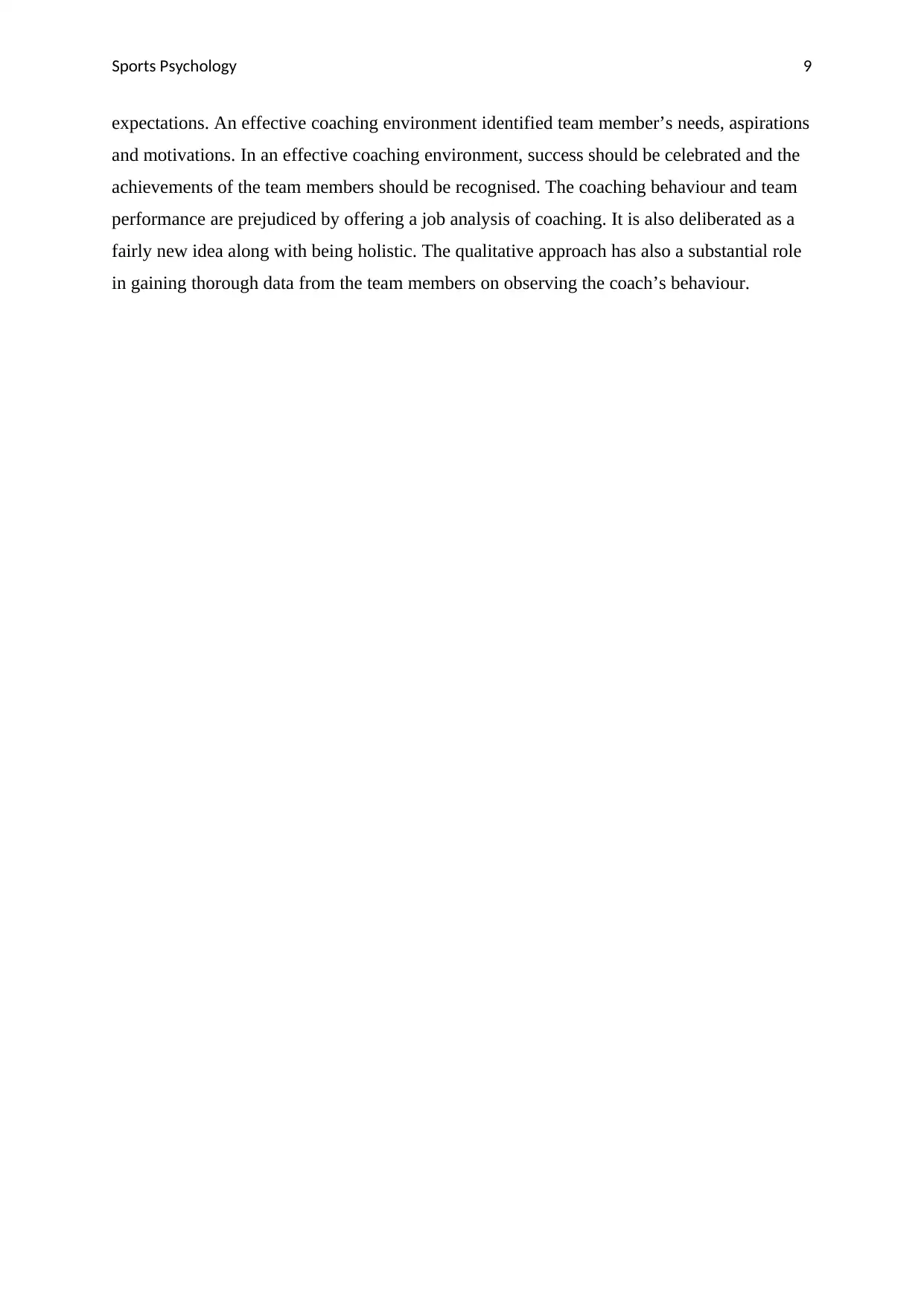
Sports Psychology 9
expectations. An effective coaching environment identified team member’s needs, aspirations
and motivations. In an effective coaching environment, success should be celebrated and the
achievements of the team members should be recognised. The coaching behaviour and team
performance are prejudiced by offering a job analysis of coaching. It is also deliberated as a
fairly new idea along with being holistic. The qualitative approach has also a substantial role
in gaining thorough data from the team members on observing the coach’s behaviour.
expectations. An effective coaching environment identified team member’s needs, aspirations
and motivations. In an effective coaching environment, success should be celebrated and the
achievements of the team members should be recognised. The coaching behaviour and team
performance are prejudiced by offering a job analysis of coaching. It is also deliberated as a
fairly new idea along with being holistic. The qualitative approach has also a substantial role
in gaining thorough data from the team members on observing the coach’s behaviour.
Paraphrase This Document
Need a fresh take? Get an instant paraphrase of this document with our AI Paraphraser
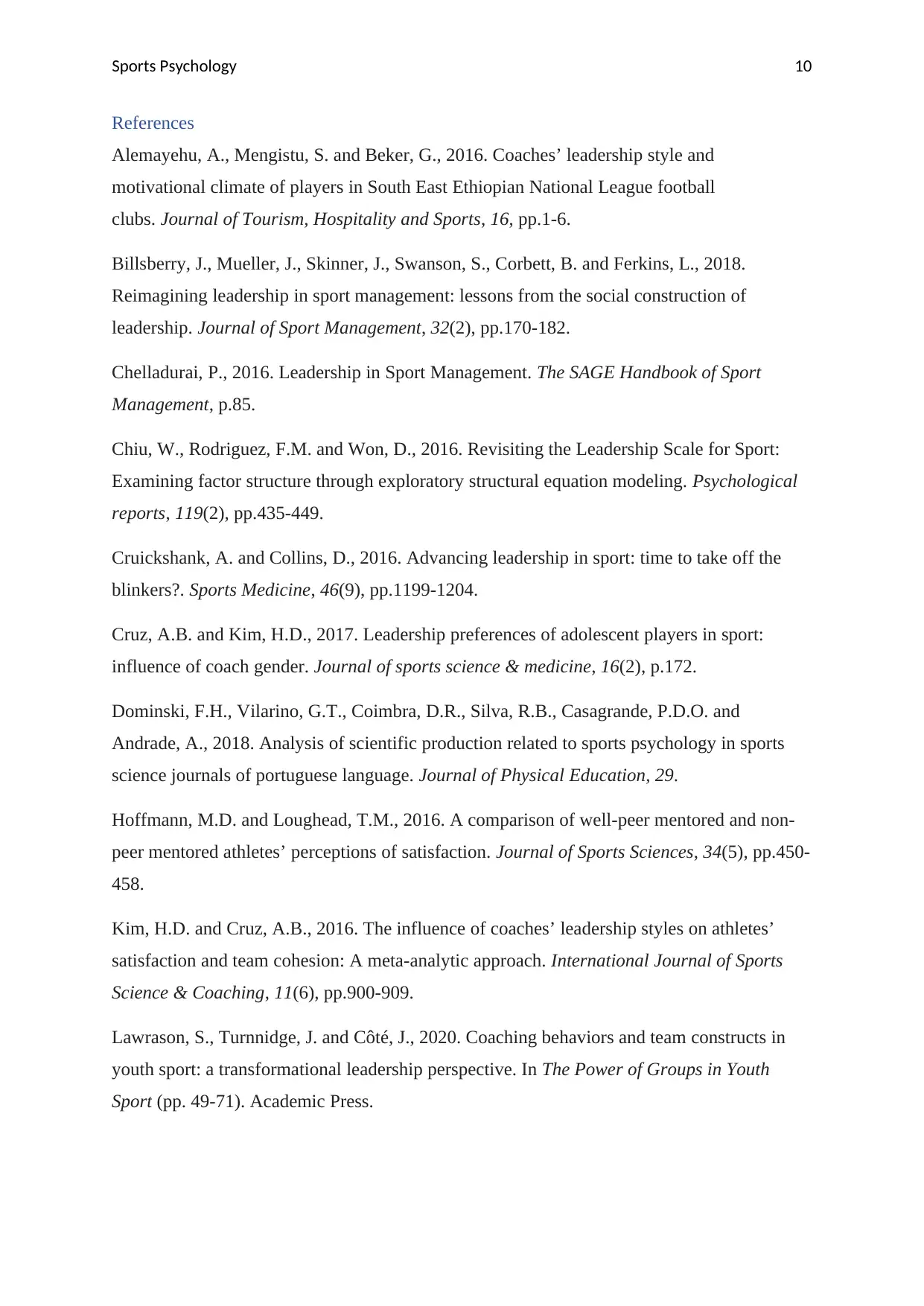
Sports Psychology 10
References
Alemayehu, A., Mengistu, S. and Beker, G., 2016. Coaches’ leadership style and
motivational climate of players in South East Ethiopian National League football
clubs. Journal of Tourism, Hospitality and Sports, 16, pp.1-6.
Billsberry, J., Mueller, J., Skinner, J., Swanson, S., Corbett, B. and Ferkins, L., 2018.
Reimagining leadership in sport management: lessons from the social construction of
leadership. Journal of Sport Management, 32(2), pp.170-182.
Chelladurai, P., 2016. Leadership in Sport Management. The SAGE Handbook of Sport
Management, p.85.
Chiu, W., Rodriguez, F.M. and Won, D., 2016. Revisiting the Leadership Scale for Sport:
Examining factor structure through exploratory structural equation modeling. Psychological
reports, 119(2), pp.435-449.
Cruickshank, A. and Collins, D., 2016. Advancing leadership in sport: time to take off the
blinkers?. Sports Medicine, 46(9), pp.1199-1204.
Cruz, A.B. and Kim, H.D., 2017. Leadership preferences of adolescent players in sport:
influence of coach gender. Journal of sports science & medicine, 16(2), p.172.
Dominski, F.H., Vilarino, G.T., Coimbra, D.R., Silva, R.B., Casagrande, P.D.O. and
Andrade, A., 2018. Analysis of scientific production related to sports psychology in sports
science journals of portuguese language. Journal of Physical Education, 29.
Hoffmann, M.D. and Loughead, T.M., 2016. A comparison of well-peer mentored and non-
peer mentored athletes’ perceptions of satisfaction. Journal of Sports Sciences, 34(5), pp.450-
458.
Kim, H.D. and Cruz, A.B., 2016. The influence of coaches’ leadership styles on athletes’
satisfaction and team cohesion: A meta-analytic approach. International Journal of Sports
Science & Coaching, 11(6), pp.900-909.
Lawrason, S., Turnnidge, J. and Côté, J., 2020. Coaching behaviors and team constructs in
youth sport: a transformational leadership perspective. In The Power of Groups in Youth
Sport (pp. 49-71). Academic Press.
References
Alemayehu, A., Mengistu, S. and Beker, G., 2016. Coaches’ leadership style and
motivational climate of players in South East Ethiopian National League football
clubs. Journal of Tourism, Hospitality and Sports, 16, pp.1-6.
Billsberry, J., Mueller, J., Skinner, J., Swanson, S., Corbett, B. and Ferkins, L., 2018.
Reimagining leadership in sport management: lessons from the social construction of
leadership. Journal of Sport Management, 32(2), pp.170-182.
Chelladurai, P., 2016. Leadership in Sport Management. The SAGE Handbook of Sport
Management, p.85.
Chiu, W., Rodriguez, F.M. and Won, D., 2016. Revisiting the Leadership Scale for Sport:
Examining factor structure through exploratory structural equation modeling. Psychological
reports, 119(2), pp.435-449.
Cruickshank, A. and Collins, D., 2016. Advancing leadership in sport: time to take off the
blinkers?. Sports Medicine, 46(9), pp.1199-1204.
Cruz, A.B. and Kim, H.D., 2017. Leadership preferences of adolescent players in sport:
influence of coach gender. Journal of sports science & medicine, 16(2), p.172.
Dominski, F.H., Vilarino, G.T., Coimbra, D.R., Silva, R.B., Casagrande, P.D.O. and
Andrade, A., 2018. Analysis of scientific production related to sports psychology in sports
science journals of portuguese language. Journal of Physical Education, 29.
Hoffmann, M.D. and Loughead, T.M., 2016. A comparison of well-peer mentored and non-
peer mentored athletes’ perceptions of satisfaction. Journal of Sports Sciences, 34(5), pp.450-
458.
Kim, H.D. and Cruz, A.B., 2016. The influence of coaches’ leadership styles on athletes’
satisfaction and team cohesion: A meta-analytic approach. International Journal of Sports
Science & Coaching, 11(6), pp.900-909.
Lawrason, S., Turnnidge, J. and Côté, J., 2020. Coaching behaviors and team constructs in
youth sport: a transformational leadership perspective. In The Power of Groups in Youth
Sport (pp. 49-71). Academic Press.
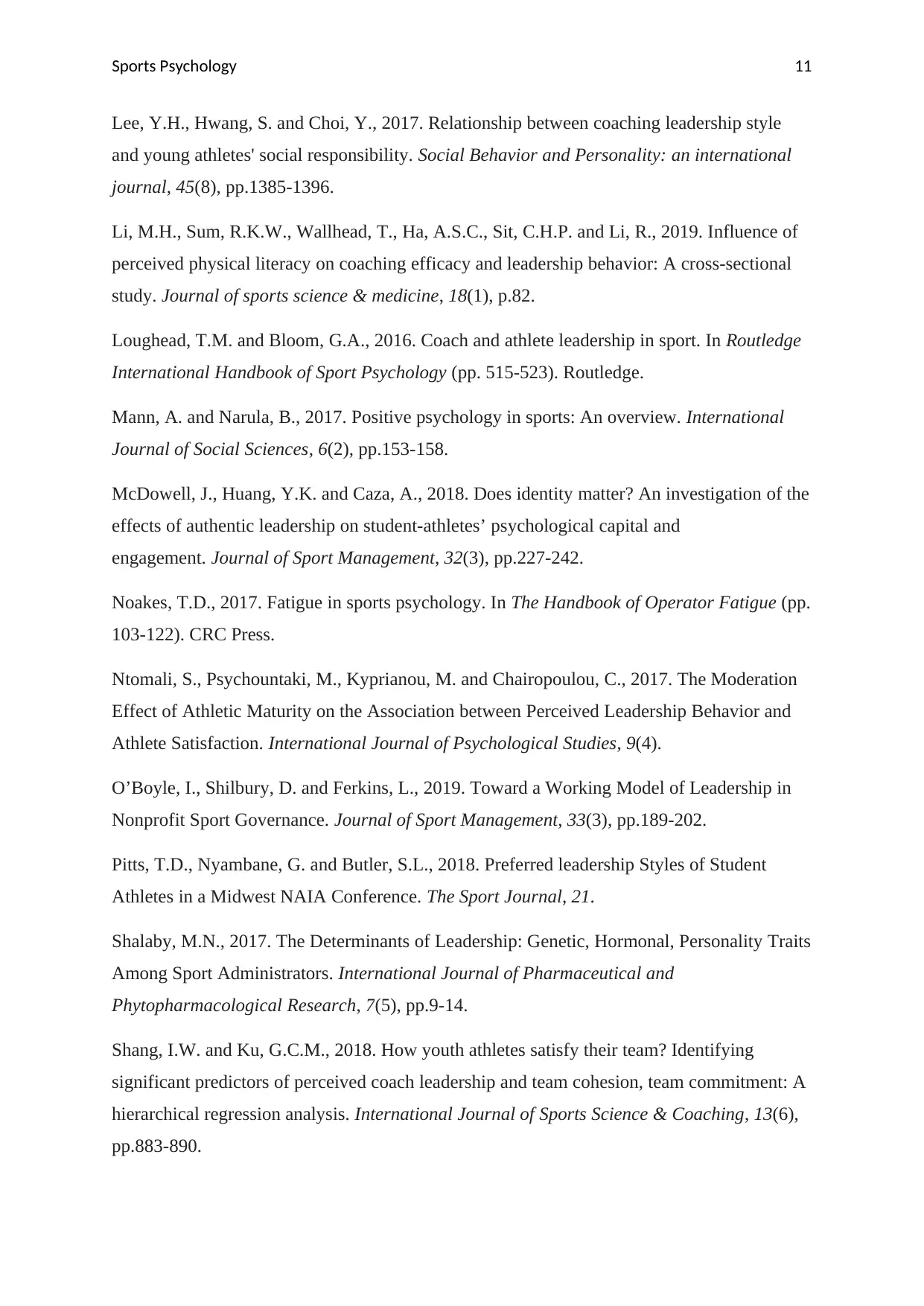
Sports Psychology 11
Lee, Y.H., Hwang, S. and Choi, Y., 2017. Relationship between coaching leadership style
and young athletes' social responsibility. Social Behavior and Personality: an international
journal, 45(8), pp.1385-1396.
Li, M.H., Sum, R.K.W., Wallhead, T., Ha, A.S.C., Sit, C.H.P. and Li, R., 2019. Influence of
perceived physical literacy on coaching efficacy and leadership behavior: A cross-sectional
study. Journal of sports science & medicine, 18(1), p.82.
Loughead, T.M. and Bloom, G.A., 2016. Coach and athlete leadership in sport. In Routledge
International Handbook of Sport Psychology (pp. 515-523). Routledge.
Mann, A. and Narula, B., 2017. Positive psychology in sports: An overview. International
Journal of Social Sciences, 6(2), pp.153-158.
McDowell, J., Huang, Y.K. and Caza, A., 2018. Does identity matter? An investigation of the
effects of authentic leadership on student-athletes’ psychological capital and
engagement. Journal of Sport Management, 32(3), pp.227-242.
Noakes, T.D., 2017. Fatigue in sports psychology. In The Handbook of Operator Fatigue (pp.
103-122). CRC Press.
Ntomali, S., Psychountaki, M., Kyprianou, M. and Chairopoulou, C., 2017. The Moderation
Effect of Athletic Maturity on the Association between Perceived Leadership Behavior and
Athlete Satisfaction. International Journal of Psychological Studies, 9(4).
O’Boyle, I., Shilbury, D. and Ferkins, L., 2019. Toward a Working Model of Leadership in
Nonprofit Sport Governance. Journal of Sport Management, 33(3), pp.189-202.
Pitts, T.D., Nyambane, G. and Butler, S.L., 2018. Preferred leadership Styles of Student
Athletes in a Midwest NAIA Conference. The Sport Journal, 21.
Shalaby, M.N., 2017. The Determinants of Leadership: Genetic, Hormonal, Personality Traits
Among Sport Administrators. International Journal of Pharmaceutical and
Phytopharmacological Research, 7(5), pp.9-14.
Shang, I.W. and Ku, G.C.M., 2018. How youth athletes satisfy their team? Identifying
significant predictors of perceived coach leadership and team cohesion, team commitment: A
hierarchical regression analysis. International Journal of Sports Science & Coaching, 13(6),
pp.883-890.
Lee, Y.H., Hwang, S. and Choi, Y., 2017. Relationship between coaching leadership style
and young athletes' social responsibility. Social Behavior and Personality: an international
journal, 45(8), pp.1385-1396.
Li, M.H., Sum, R.K.W., Wallhead, T., Ha, A.S.C., Sit, C.H.P. and Li, R., 2019. Influence of
perceived physical literacy on coaching efficacy and leadership behavior: A cross-sectional
study. Journal of sports science & medicine, 18(1), p.82.
Loughead, T.M. and Bloom, G.A., 2016. Coach and athlete leadership in sport. In Routledge
International Handbook of Sport Psychology (pp. 515-523). Routledge.
Mann, A. and Narula, B., 2017. Positive psychology in sports: An overview. International
Journal of Social Sciences, 6(2), pp.153-158.
McDowell, J., Huang, Y.K. and Caza, A., 2018. Does identity matter? An investigation of the
effects of authentic leadership on student-athletes’ psychological capital and
engagement. Journal of Sport Management, 32(3), pp.227-242.
Noakes, T.D., 2017. Fatigue in sports psychology. In The Handbook of Operator Fatigue (pp.
103-122). CRC Press.
Ntomali, S., Psychountaki, M., Kyprianou, M. and Chairopoulou, C., 2017. The Moderation
Effect of Athletic Maturity on the Association between Perceived Leadership Behavior and
Athlete Satisfaction. International Journal of Psychological Studies, 9(4).
O’Boyle, I., Shilbury, D. and Ferkins, L., 2019. Toward a Working Model of Leadership in
Nonprofit Sport Governance. Journal of Sport Management, 33(3), pp.189-202.
Pitts, T.D., Nyambane, G. and Butler, S.L., 2018. Preferred leadership Styles of Student
Athletes in a Midwest NAIA Conference. The Sport Journal, 21.
Shalaby, M.N., 2017. The Determinants of Leadership: Genetic, Hormonal, Personality Traits
Among Sport Administrators. International Journal of Pharmaceutical and
Phytopharmacological Research, 7(5), pp.9-14.
Shang, I.W. and Ku, G.C.M., 2018. How youth athletes satisfy their team? Identifying
significant predictors of perceived coach leadership and team cohesion, team commitment: A
hierarchical regression analysis. International Journal of Sports Science & Coaching, 13(6),
pp.883-890.
⊘ This is a preview!⊘
Do you want full access?
Subscribe today to unlock all pages.

Trusted by 1+ million students worldwide
1 out of 13
Your All-in-One AI-Powered Toolkit for Academic Success.
+13062052269
info@desklib.com
Available 24*7 on WhatsApp / Email
![[object Object]](/_next/static/media/star-bottom.7253800d.svg)
Unlock your academic potential
Copyright © 2020–2025 A2Z Services. All Rights Reserved. Developed and managed by ZUCOL.


